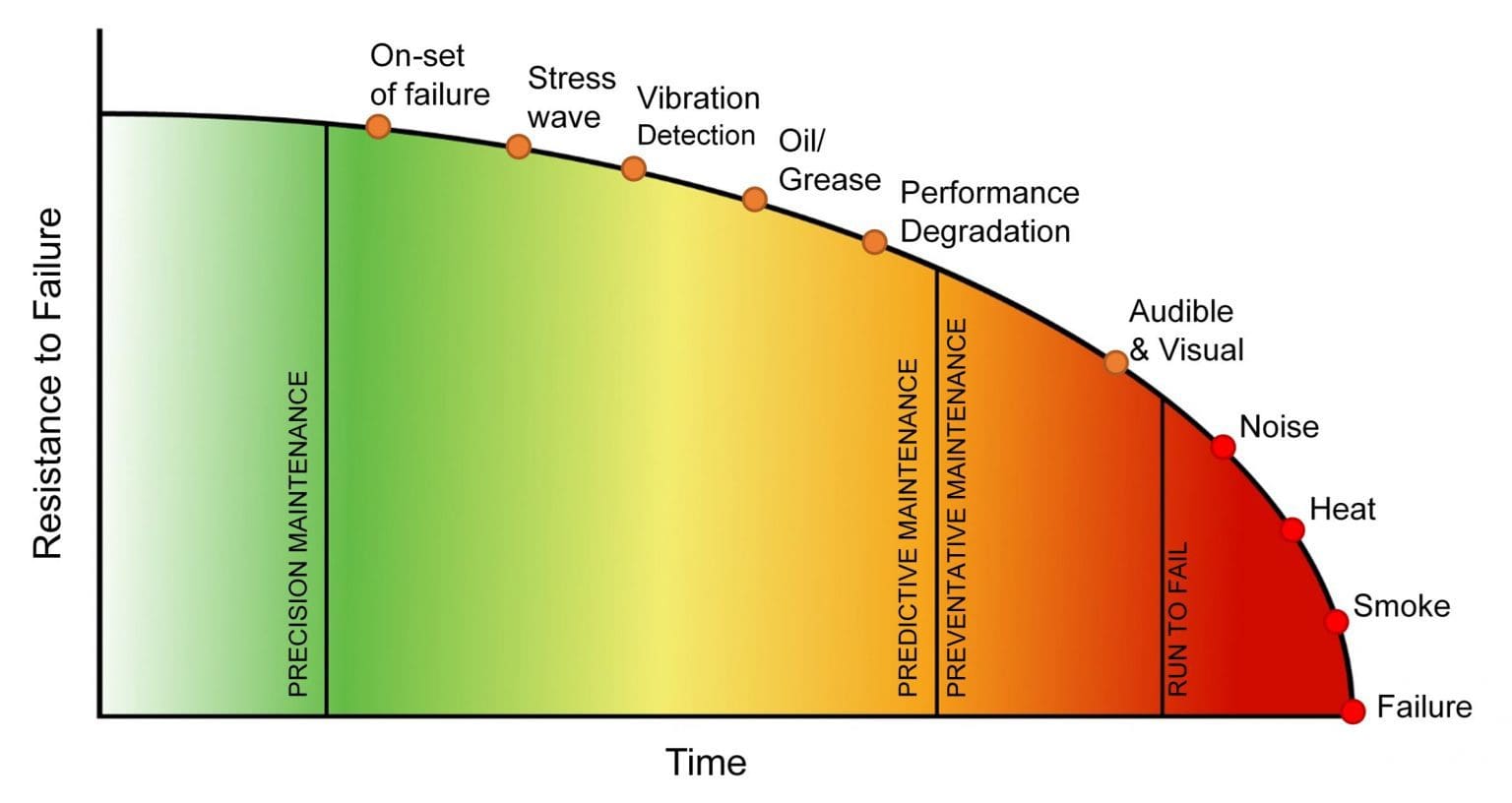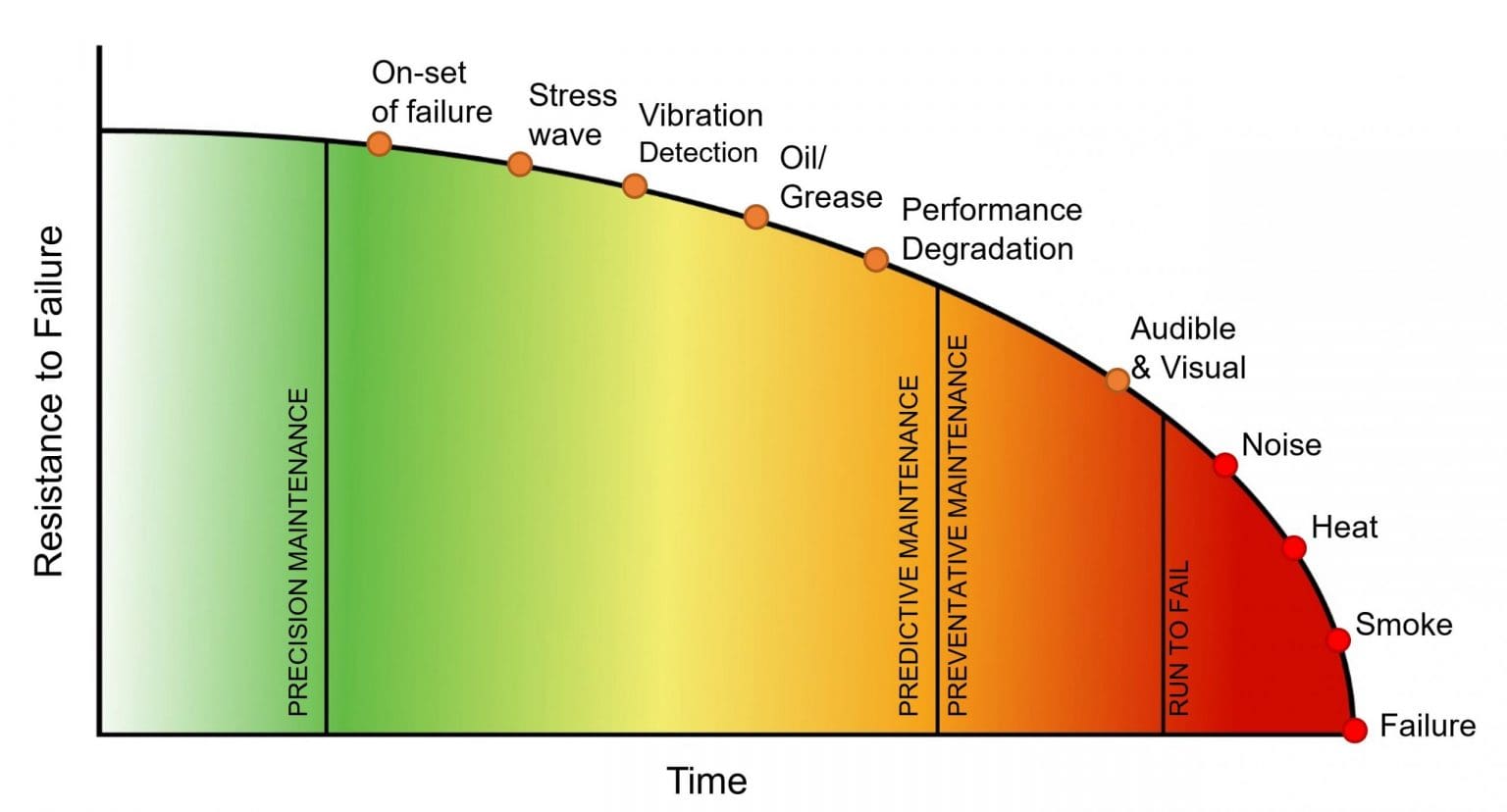When applying our available technologies, an understanding is required of the expected failure modes. Table 1 below highlights the typical faults and associated equipment capabilities for each technology:
| Fault |
Vibration |
Stresswave / Enveloping / Shock Pulse |
Thermography |
Ultrasonics |
Lubricant Analysis |
Motor/ Current Analysis |
Video Deflection Technologies / ODS Analysis |
| Bearing Defects |
x |
x |
|
|
x |
|
|
| Gear Defects |
x |
x |
|
|
x |
|
|
| Rotor/Stator Defects (Electric Motors) |
x |
x |
|
|
|
x |
|
| Coupling/Belt Defects |
x |
|
|
|
|
|
|
| Mechanical Looseness |
x |
|
|
|
|
|
x |
| Misalignment |
x |
x |
|
|
|
|
x |
| Unbalance |
x |
|
|
|
|
|
|
| Lubrication Problems |
x |
x |
|
|
x |
|
|
| Temperature Problems |
|
|
x |
|
|
|
|
| Electrical Problems (Temperature Related) |
|
|
x |
|
|
|
|
| Air Leaks |
|
|
|
x |
|
|
|
| Structural Defects |
|
|
|
|
|
|
x |
Our CBM programs are designed and operated to ensure the correct technologies are applied to give the earliest indication of asset faults controlling risk of failure but also helping to control maintenance spend where unnecessary maintenance costs and resource utilisation can be mitigated.
As a living program our CBM managed services ensure a continuous improvement view with our personnel aiming to be a key important part of your maintenance and engineering teams. The P-F curve shown below highlights some of the typical detection order for applied technologies on a typical asset between the on-set of failure through to functional failure.
Fig 1.

Deployment – Site Setup and Standards
As part of the initial setup, all our engineers are trained to the required ISO/PCN standard to ensure all measurement locations and database parameters are in line with class and industry standards. During the setup phase, our consultants’ experience in liaising with your team will ensure measurement locations are accessible and standardised, ensuring data can be collected with consistency and accuracy with health and safety at the forefront of the approach.
Where machinery is required to be added to the monitoring scope and is deemed inaccessible due to safety or other reasons, we will document and discuss the requirements with your team to recommend alternatives.
During the setup phase we will:
- Attend the site and agree with the client’s team the best utilisation of the time available to setup the measurement locations.
- Carry out measurement location selection and review marking all required locations. Proceed and complete the marking of all locations with the necessary material and adhesive.
- Photograph all measurement locations to compile the setup report following the attendance.
- Collect and confirm all required technical information to build this detail into the database as per the currently used database.
- Carry out initial baseline survey in conjunction with your team, concentrating on the most critical assets first (where time allows).
- Completion of initial report and setup documentation
Our remote analysis service has proved very successful for our clients in the prevention of failures but also in the continuous improvement measures to the client’s maintenance standards and programmes.
Our analysis will encompass or at the very least make recommendations for the addition and inclusion of other CBM technologies to aid in the analysis and prevention of machinery failure.
For example, where clients are utilising other oil laboratories for the lubricating oil analysis, it is possible for us to request the latest analysis results to aid in the analysis of the vibration data but also to include the results from the client’s incumbent laboratory into our web-based reporting platform.
Figure 2 shows the typical problem to failure curve of a rotating plant asset and the various time scales and technologies that could be included to give a full assessment of asset condition.
Fig 2.

Our knowledge of multiple technologies ensures the most suitable testing equipment and technique is employed and directly links to realistic engineering recommendations within our reports.
Ongoing – Consultant and Analyst Skills and Experience
All our consultants and engineers are qualified to the relevant ISO/PCN standard for vibration analysis and deal with analysis from client’s data on a daily basis. All consultants and engineers are qualified and competent in the analysis of rotating plant and structural data ensuring the analysis is completed with the upmost accuracy along with clear, concise and realistic engineering and maintenance recommendations.
Ongoing – Reporting templates and standards using the Cloud-based Asset INSIGHT 365 System
We operate analysis on a web-based reporting platform that is fully accessible to its clients once contracts are in operation and the system still has the capability to produce PDF style reports as per client requirements.
Data that has been collected is sent to our head office, based in the UK, to our dedicated email system (unless otherwise agreed) with procedures in place for correct file naming protocols. Depending on email file size limitations, a suitable FTP (File Transfer Protocol) or alternative web-based file transfer software will be employed.
Our remote analysts will liaise with your maintenance personnel during the on-set of the programme to determine the most reliable solution for data communication.
We will assign competent diagnostic engineers to analyse the data and produce detailed exception reports (in line with our quality procedures).
We operate a web-based reporting platform to store analytical results from all CBM technologies applied on a client’s fleet. This platform, due to the web-based element, removes the need for software installation to review the results, however, reports are still produced and sent to our clients as PDF’s depending on requirements, i.e. restricted internet access aboard vessels.
The main benefits of the Asset Insight web-based reporting system are:
- Fully secure web-based reporting platform for multiple technologies
- No installation required – Web access
- All interim and full vessel and fleet reports available electronically 24/7/365
- This system is designed, operated and maintained by the us and therefore, means any adjustments or new features can be discussed, agreed and added to improve the client user experience
- Integration and automated upload to vessel PMS/CMMS system through XML or CSV (typical file types but others are available)
- Full audit trail to determine dates and times when each user logged on or adjusted any data within the system
- Different views available to show data for a vessel, a group of vessels or the fleet as required
All reports are provided in a PDF report with options to feed information directly into the vessel PMS or CMMS (please note this would require a compatibility review and may incur additional costs)
The web-based platform also records several key program management KPI’s.
Ongoing – Technical Support for Hardware and Software including calibration check support
As part of the ongoing analytical support, we will also provide hardware and software support to troubleshoot the monitoring programme issues that may arise. Support, troubleshooting and queries to be supported on the following typical elements:
Data collection
- Software installation and re-registration (licensing – please note a single user licence and installation has been selected within this proposal)
- Data transfer and communication
- New machinery additions (point selection and documentation for class records)
- Cable or sensor issues – assessment to determine if replacement parts needed (parts and accessories will be quoted and will be chargeable)
- Recommended 2 yearly calibration check – Unit to be shipped to our head office for inspection and calibration check
- Asset retests to confirm faults
- Telephone and Email support for queries


